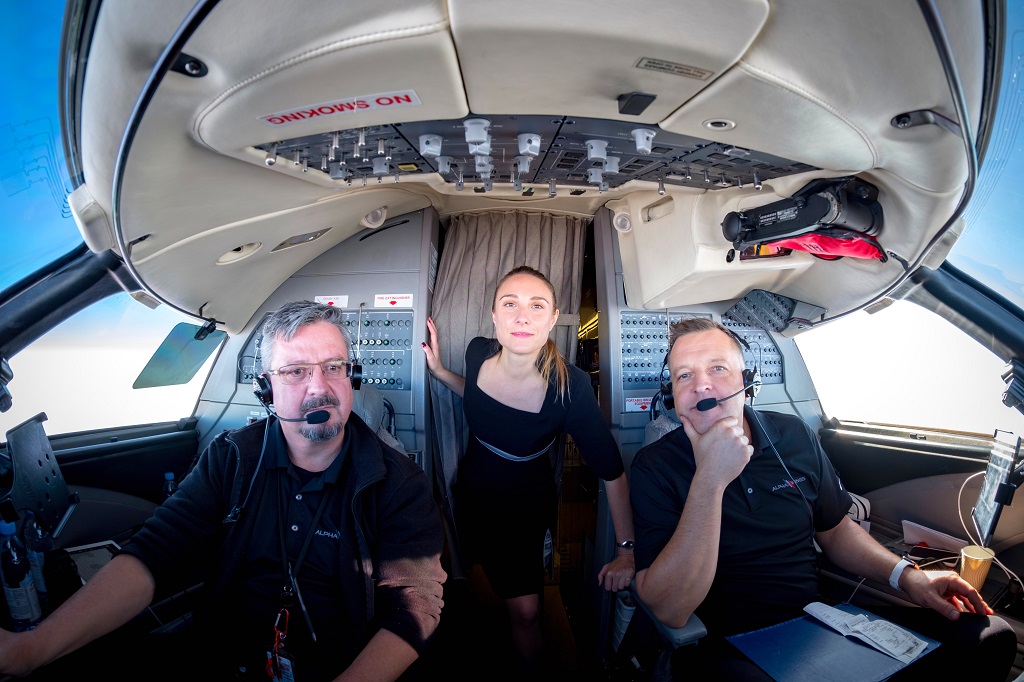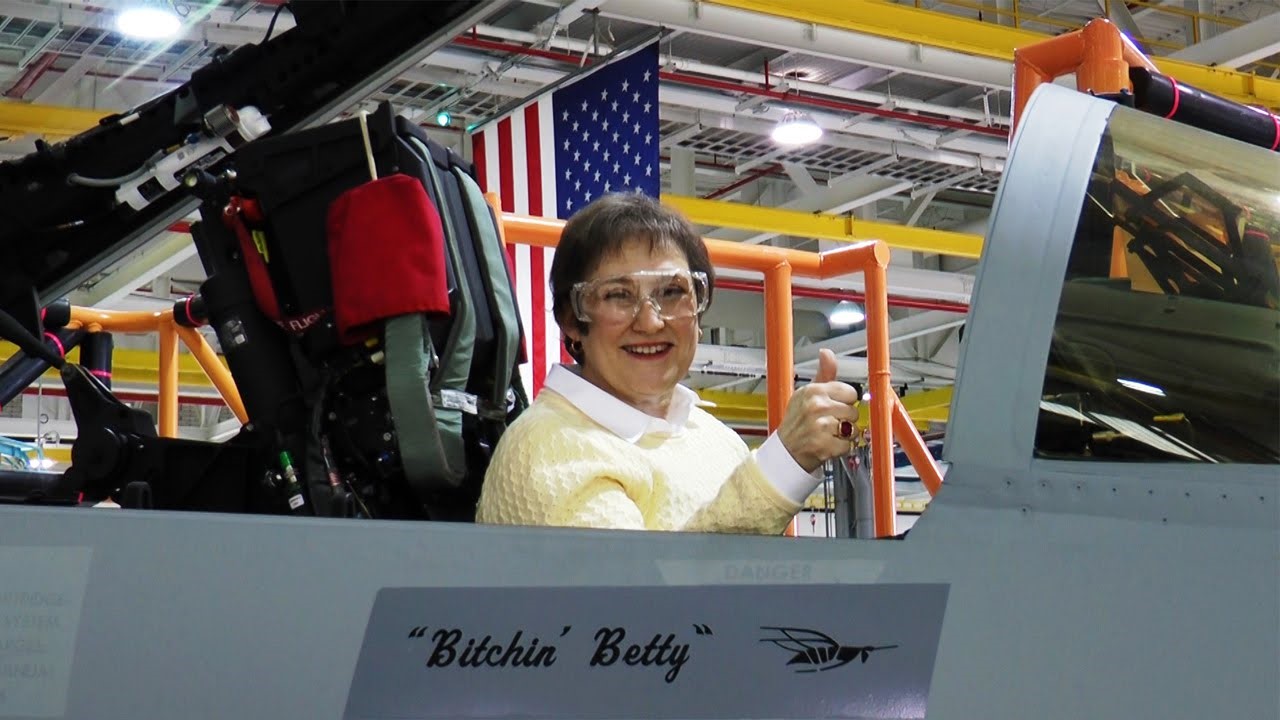“Bitchy Betty” and modern audio interfaces: why do they speak in a female voice?
Audio interfaces surround us everywhere: in the form of voice assistants, a navigation system in the car and public transport. They have been used in military equipment for a long time - speech informants transmit commands and tips to the crew of aircraft from the mid-twentieth century.
US military pilots nicknamed the Bitchin 'Betty Voice Bitch Betty Voice Instruments for their demanding intonation. Today we’ll talk about Betty’s counterparts and see why female voices are more common than male voices in audio interfaces.

Photo Richard Gatley / Unsplash
One of the first aircraft with an audio information system was the B-58 Hustler bomber built by Convair in the late fifties. The company hired actress Joan Elms (Joan Elms) - she recorded twenty short messages for the airline. The officers called Elms' voice “Sexy Sally” (the word “bitching”, bitchy, was not yet in use, so the first “voice assistant” was christened differently). She could warn of subsystem malfunctions or inform about the readiness for launching missiles.
In the 1970s, McDonnell Douglas launched the F-15 Eagle fighter. The phrases for him were recorded by an employee of the company Kim Crow (Kim Crow). At first, the system contained a minimum of short messages: “Attention!”, “Engine fire!”, “Overheating!”. However, by the beginning of the nineties, Betty Bitchy had “learned” to speak many phrases that accompanied an automated system for detecting threats and failures. Kim Crowe subsequently left the aircraft and began to engage in voice acting films, play in the theater, cinema and on television.

YouTube video screenshot / “Bitchin 'Betty” Says Farewell: Beloved Voice Behind Boeing's F / A-18
And yet the best-known modern Betty is Leslie Shook, who replaced Crowe. Her voice was given command by the system in the American fighter Boeing F / A-18 Super Hornet. Earlier we talked about it in our other material about audio interfaces.
On domestic aircraft, the RI-65 system is often installed as an informant. Her messages are also voiced by a female voice, to which the pilots gave the name "Rita" - phrases inform the crew about failures, achievement of maximum limits and the threat that arose. In the recording below, you can compare the voices of various Betty and Rit.
In some modern aviation systems, the voice of a voice informant in an airplane can be either female or male. The latter was nicknamed the "Barking Bob" (Barking Bob) - it is used on Boeing passenger airliners.
There are several theories about why a female voice is preferred in voice interfaces. It is believed that Joan Elms was chosen as an announcer, since in the 50s US military aviation was the “patrimony of men” - the female voice in the cockpit sounded unusual and immediately attracted the attention of the pilot. In addition, it was easier to distribute: if the technique began to junk, then the male one quickly became slurred due to the lower timbre. In some ways, Convair and other airlines of the last century were right: studies have shown that people have different perceptions of male and female speech. Scientists from the University of Sheffield conducted an experiment during which men listened to recordings of various voices.
Another study was conducted by Phil McAleer, a psychologist at the University of Glasgow. He recorded the speech of 64 men and women (they were asked to read aloud a short text). After that, everything except the word “Hello” was deleted from the received records. Next, McAllier asked 320 respondents to rate these “Hello” by ten criteria, such as “reliability,” “aggressiveness,” “confidence,” and “warmth.” It turned out that women's voices caused the focus group more confidence. Two main factors influenced this. The first is the pitch: participants noted that a high voice sounds more friendly. The second is intonation: when a woman lowers her at the end of a sentence, the listener has a feeling of confidence.
Female voices are used not only in aviation, but also on almost all audio interfaces. The same Siri is by default feminine in most countries except the UK, the Netherlands, France and the Middle East. The Russian "Alice" speaks in the voice of actress Tatyana Shitova - by the way, she voices Scarlett Johansson in a Russian-language dubbing.
The situation is somewhat different with the voice assistant Alexa. She also speaks in a female voice, but her speech is completely synthesized. At the same time, the system allows small voice changes. She can speak with different accents: British, Canadian, Australian and others. In addition, this year the assistant received the voice of actor Samuel L. Jackson.

Photo Dan Gold / Unsplash
Other development companies are also beginning to turn to synthesized speech (and also use male voices on a par with women). For example, in Yandex.Navigator 24 voice options are now available . Among them, the voice of the MiG-35 pilot Mikhail Belyaev and Master Yoda.
The trend towards gender equality dictates its own rules: both voice assistants and speech informants receive different voices - including in aviation. They also work on gender-neutral assistants so that no one is offended. True, the pilots do not seem to like such voices - they, in turn, were nicknamed “Bitchin 'Borgs”.
Additional reading - in our "World of Hi-Fi":
 Audio Interfaces: Sound as a source of information on the road, in the office and in the sky
Audio Interfaces: Sound as a source of information on the road, in the office and in the sky
 “Finds of an Audio Man”: a tree of musical genres, satellite broadcasts and a GitHub-xylophone
“Finds of an Audio Man”: a tree of musical genres, satellite broadcasts and a GitHub-xylophone
 Listening to informational noise: music and videos that no one should have found
Listening to informational noise: music and videos that no one should have found
 What noise helps to relax, and yet - prevents hearing loss in severe accidents
What noise helps to relax, and yet - prevents hearing loss in severe accidents
 Why do different people perceive the same sounds differently
Why do different people perceive the same sounds differently
 The phenomenon of ASMR audio: goosebumps and pleasant tingling
The phenomenon of ASMR audio: goosebumps and pleasant tingling
 A smile can sound and it's contagious
A smile can sound and it's contagious
US military pilots nicknamed the Bitchin 'Betty Voice Bitch Betty Voice Instruments for their demanding intonation. Today we’ll talk about Betty’s counterparts and see why female voices are more common than male voices in audio interfaces.

Photo Richard Gatley / Unsplash
The Story of Bitchy Betty
One of the first aircraft with an audio information system was the B-58 Hustler bomber built by Convair in the late fifties. The company hired actress Joan Elms (Joan Elms) - she recorded twenty short messages for the airline. The officers called Elms' voice “Sexy Sally” (the word “bitching”, bitchy, was not yet in use, so the first “voice assistant” was christened differently). She could warn of subsystem malfunctions or inform about the readiness for launching missiles.
In the 1970s, McDonnell Douglas launched the F-15 Eagle fighter. The phrases for him were recorded by an employee of the company Kim Crow (Kim Crow). At first, the system contained a minimum of short messages: “Attention!”, “Engine fire!”, “Overheating!”. However, by the beginning of the nineties, Betty Bitchy had “learned” to speak many phrases that accompanied an automated system for detecting threats and failures. Kim Crowe subsequently left the aircraft and began to engage in voice acting films, play in the theater, cinema and on television.

YouTube video screenshot / “Bitchin 'Betty” Says Farewell: Beloved Voice Behind Boeing's F / A-18
And yet the best-known modern Betty is Leslie Shook, who replaced Crowe. Her voice was given command by the system in the American fighter Boeing F / A-18 Super Hornet. Earlier we talked about it in our other material about audio interfaces.
On domestic aircraft, the RI-65 system is often installed as an informant. Her messages are also voiced by a female voice, to which the pilots gave the name "Rita" - phrases inform the crew about failures, achievement of maximum limits and the threat that arose. In the recording below, you can compare the voices of various Betty and Rit.
In some modern aviation systems, the voice of a voice informant in an airplane can be either female or male. The latter was nicknamed the "Barking Bob" (Barking Bob) - it is used on Boeing passenger airliners.
Why are women’s voices used more often?
There are several theories about why a female voice is preferred in voice interfaces. It is believed that Joan Elms was chosen as an announcer, since in the 50s US military aviation was the “patrimony of men” - the female voice in the cockpit sounded unusual and immediately attracted the attention of the pilot. In addition, it was easier to distribute: if the technique began to junk, then the male one quickly became slurred due to the lower timbre. In some ways, Convair and other airlines of the last century were right: studies have shown that people have different perceptions of male and female speech. Scientists from the University of Sheffield conducted an experiment during which men listened to recordings of various voices.
The researchers found that the subjects' brains interpreted sounds differently: female speech caused activity in the temporal lobe of the cerebral cortex (its parts are responsible, for example, for processing music), and male speech in the occipital lobe. One of the conclusions of the study: the female voice sounds clearer, including because it is processed by the "specialized" part of the brain - as a result, the brain is "easier to decode" female speech.
Another study was conducted by Phil McAleer, a psychologist at the University of Glasgow. He recorded the speech of 64 men and women (they were asked to read aloud a short text). After that, everything except the word “Hello” was deleted from the received records. Next, McAllier asked 320 respondents to rate these “Hello” by ten criteria, such as “reliability,” “aggressiveness,” “confidence,” and “warmth.” It turned out that women's voices caused the focus group more confidence. Two main factors influenced this. The first is the pitch: participants noted that a high voice sounds more friendly. The second is intonation: when a woman lowers her at the end of a sentence, the listener has a feeling of confidence.
Voice assistants now
Female voices are used not only in aviation, but also on almost all audio interfaces. The same Siri is by default feminine in most countries except the UK, the Netherlands, France and the Middle East. The Russian "Alice" speaks in the voice of actress Tatyana Shitova - by the way, she voices Scarlett Johansson in a Russian-language dubbing.
The situation is somewhat different with the voice assistant Alexa. She also speaks in a female voice, but her speech is completely synthesized. At the same time, the system allows small voice changes. She can speak with different accents: British, Canadian, Australian and others. In addition, this year the assistant received the voice of actor Samuel L. Jackson.

Photo Dan Gold / Unsplash
Other development companies are also beginning to turn to synthesized speech (and also use male voices on a par with women). For example, in Yandex.Navigator 24 voice options are now available . Among them, the voice of the MiG-35 pilot Mikhail Belyaev and Master Yoda.
The trend towards gender equality dictates its own rules: both voice assistants and speech informants receive different voices - including in aviation. They also work on gender-neutral assistants so that no one is offended. True, the pilots do not seem to like such voices - they, in turn, were nicknamed “Bitchin 'Borgs”.
Additional reading - in our "World of Hi-Fi":
 Audio Interfaces: Sound as a source of information on the road, in the office and in the sky
Audio Interfaces: Sound as a source of information on the road, in the office and in the sky
 “Finds of an Audio Man”: a tree of musical genres, satellite broadcasts and a GitHub-xylophone
“Finds of an Audio Man”: a tree of musical genres, satellite broadcasts and a GitHub-xylophone
 Listening to informational noise: music and videos that no one should have found
Listening to informational noise: music and videos that no one should have found
 What noise helps to relax, and yet - prevents hearing loss in severe accidents
What noise helps to relax, and yet - prevents hearing loss in severe accidents
 Why do different people perceive the same sounds differently
Why do different people perceive the same sounds differently
 The phenomenon of ASMR audio: goosebumps and pleasant tingling
The phenomenon of ASMR audio: goosebumps and pleasant tingling
 A smile can sound and it's contagious
A smile can sound and it's contagious
All Articles